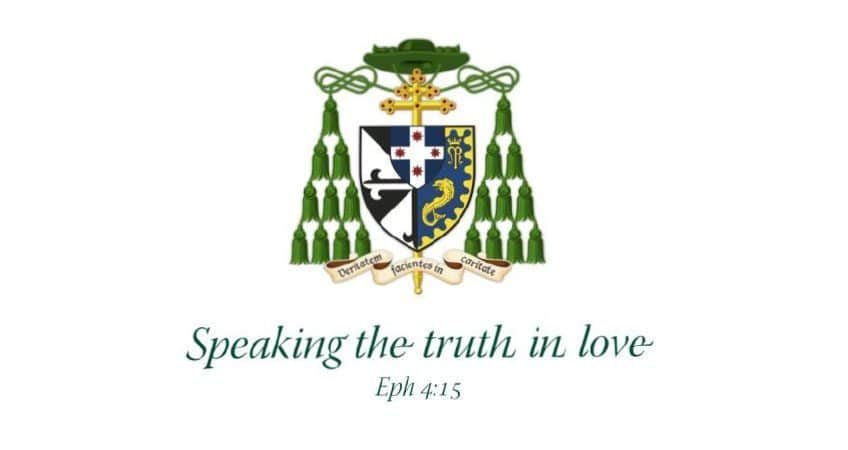Homily for the Solemn Pontifical Funeral Mass of George Cardinal Pell AC

St Mary’s Basilica, Sydney, Feast of the Presentation of the Lord, 2 February 2023
In 2007 Cardinal Pell issued guidelines reminding clergy that funeral homilies should focus on the Scriptures and the Catholic faith, especially regarding the Resurrection and God’s mercy, and not be a eulogy or canonisation ceremony for the deceased. So, this one last time, Your Eminence, I will try to do as I’m told…
In today’s Gospel, Jesus tells us to be ever-vigilant, like a householder on the lookout for a burglar, so that when the Lord comes we will be ready (Lk 12:35-40). In the previous chapter Luke records another parable about determination, this time of a man banging on his neighbour’s door in the middle of the night asking to borrow bread to entertain his guests (Lk 11:5-8). The Greek word ἀναίδεια is rendered ‘persistence’ in most translations,[1] since Jesus is commending perseverance in prayer and vigil. Yet persistence is a rather mild word for someone banging on the door at 2 a.m. for party supplies! Ἀναίδεια was the Greek goddess of shamelessness or ruthlessness, and she lent her name to the quality of unembarrassed determination, regardless of circumstances.[2] In keeping vigil and persevering in prayer, in preaching the Gospel in season and out, and in pastoral outreach to every lost sheep, Christians should demonstrate an audacity that means they keep at it when others would give up.
It took more than a bit of Christian shamelessness for the son of a Ballarat publican to take a Roman monastery with church, renovate it to Australian comfort standards, radically redecorate it, and so establish an Aussie watering hole—er, pilgrim house—in the heart of the Eternal City. It took boldness to get the Bishops of Australia and St Mary’s Cathedral Choir there for the opening. And it took sheer importunity to bang on the door of the Pope, asking him to bless and open the place—perhaps the only hotel ever opened by a pope! Yet ἀναίδεια was on-brand for Pell, and it enabled him to bring us not only Domus Australia but three good seminaries, four new Catholic tertiary institutions, the Benedict XVI Retreat Centre, the John Paul Centre at Sydney Uni, several new institutes of consecrated women, a vastly expanded tertiary and youth apostolate, and World Youth Day—like the Domus opening, stuffed full of pope, bishops and musicians, but with half a million idealistic young adults to boot!
Domus Australia is a high standard hospitality centre for Aussie pilgrims in Rome. Yet to tour its chapel and public spaces is also to revisit the history and faith of the Church in Australia, and to peer into the soul of George Pell.
The piety of earlier generations is told in the beautiful chapel architecture, and in the rather sentimental paintings inherited from the Marists of The Holy Family, Our Lady of the Rosary, and The Souls in Purgatory. In his makeover, the Cardinal added altarpieces by Paul Newton of Our Lady of the Southern Cross and of the First Catholics praying before the Blessed Sacrament in 1818, as well as decorating the sanctuary with Aussie emblems, flora and fauna. Around the house we find images of the two Aboriginal novice monks who joined St Paul’s in Rome, and many items of indigenous Australian sacred art.
So, while he rose to international prominence and roles, the Cardinal remained very much an Australian to the end. As the Church had made enormous contributions to this great nation, he was convinced it has many strengths, and will yet do much more good if it remains faithful to the apostolic tradition. So, all around Domus we see representations of St Mary MacKillop and Australia’s first bishops, priests, nuns and laity, of First Australians, convicts and migrants, and what they built.
There are portraits also of contemplatives such as Brigid, Thérèse of Lisieux and Bishop-Abbot Salvado—for Christians are people of prayer and the Cardinal drew from that well his composure amidst great challenges. Faithful to the Divine Office and mental prayer, he offered the Holy Sacrifice more than 20,000 times.
On the walls of Domus there are also images of star pastors like Pius V, John Joseph Therry, Daniel Mannix and John Paul—and for 56 years as a priest and 35 as a bishop the Cardinal’s primary concerns were pastoral. Jesus told Peter to feed the sheep but also the lambs (Jn 21:15), and George devoted much energy to building up young people through education, evangelisation, youth ministry, vocational discernment and, of course, WYD-SYD08, the happiest and holiest week in the history of this nation.
There are paintings, too, of missionaries, preachers and founders, such as Patrick, Dominic and Francis Xavier—for the Cardinal was an erudite preacher and public commentator, admired and hated for his willingness to contend with the culture on behalf of Christ and His Church. There are servants of the poor represented also, such as Mother Teresa with a beggar, and the first nuns who built so much of Australia’s health and welfare infrastructure—as the Cardinal knew weak humanity needs the Church’s works of mercy. There are educationalists, too, such as Mary Ward, Newman and MacKillop—for the Cardinal’s great passion was for truth and the life of the mind led him to create, defend and strengthen Catholic education at every level.
There are also several martyrs portrayed: Fisher, More and Campion, Paul Miki, Andrew Kim and Peter Chanel. But the most powerful portrait is that of the white martyr, Cardinal Francis-Xavier Nguyễn Văn Thuận with his arms outstretched, kneeling in prayer in his prison cell. Little did Cardinal Pell know when he commissioned this work, that his turn would come to spend 404 days in solitary confinement on what he good-humouredly called his “extended spiritual retreat”. But then, John the Baptist, the apostles, and Jesus Himself all had their prison time.[3]
Jesus told His disciples not to be surprised if the world hated them, as it had hated Him first. Persecution and suffering would be their opportunity to give witness. And so, the Cardinal accepted his fate with equanimity and forgiveness. Forbidden even to say Mass privately in his cell, he found a new apostolate fulfilling Jesus’ call to visit and proclaim mercy to prisoners, as he corresponded with inmates from his cell.[4] He could say with Paul “For your sake we are massacred daily and reckoned as sheep for the slaughter. These are the trials through which we triumph, by the power of Him who loved us.” (Rom 8:36).
Each painted hero in our Aussie pilgrim house gives us a peek into what drove George Pell the man and priest: his passions for evangelisation, education, welfare, worship and witness. But they also remind us of the many ways we can be saints—virtuous souls who ultimately abide safely in God’s hands (Wis 3:1-9). It is their company that the Cardinal hoped to join in heaven and their communion in which he strived to live on earth. Pope Francis recently called George ‘a great guy’ to whom ‘we owe so much’. Not everyone agrees. But if some experienced him as demanding, pugilistic or polarising, and others as faithful, hospitable and witty, it’s now the turn of the saints to endure his teasing, lecturing or commands…
What all these saints and heroes had in common, of course, is faith in Jesus Christ. They spent their lives conforming themselves to His teachings and graces, above all to His life, death and resurrection. And so, in the courtyard at the heart of the Domus Australia complex stands a life-sized bronze of The Risen Christ.
George Pell’s name saint was the rather martial St George. He was popularised as Patron of England by Richard I (1157–99), the King of England at the end of the 12th century who wore the cross of St George on his chest. 6ft 5in tall, striking and athletic, Richard dominated every room he entered. He was a far from perfect prince, but the calumnies of his enemies were baseless and his imprisonment wrongful, and he is remembered by history as Cœur de Lion—The Lionheart—because of his courage. George Pell was also a giant of a man with a big vision, who looms large in the history of the Church in Australia and amongst churchmen internationally. He had a big heart, too, strong enough to fight for the faith and endure persecution, but soft enough to care for priests, youth, the homeless, prisoners and imperfect Christians. Ultimately that heart gave out, but only after more than eighty years of being gradually conformed to the Sacred Heart of Jesus.
23 days ago the lion’s roar was unexpectedly silenced. But George the Lionheart was dressed with the cross on his chest and ready, awaiting His Master’s return. His influence has been far-reaching and we can be confident it will long continue. He may even be more effective from his new address! Only yesterday I celebrated Mass to welcome seventeen new admissions to Sydney’s Seminary of the Good Shepherd. That’s the largest intake in the history of Good Shepherd Seminary: you have to go back 37 years to 1986 since that many entered its predecessor seminary of St Patrick’s Manly. For our family to receive seventeen newcomers as it loses one leonine old-timer is a great grace!
I know that Cardinal Pell, such a great friend of seminarians and young priests, and such a believer in the good that priests do, was interceding for this. At this news I expect he is doing cartwheels with his new hips and heart in heaven! God grant an eternal reward to this man of ἀναίδεια, who loved his Lord and served his Church shamelessly, vehemently, courageously to the end.
[1] NRSVCE, ASV, GN, LB, NCB etc.
[2] https://www.billmounce.com/greek-dictionary/anaideia; Alan Johnson, “Assurance for man: The fallacy of translating anaideia by ‘persistence’ in Luke 11:5-8,” Journal of the Evangelical Theological Society 22(2) (June 1979): 123-131, and the sources therein.
[3] Imprisonment of John the Baptist (Mt 11:2; 14:3-12), Peter (Acts 12:3-19), Paul (Acts 16:19-40; 22:24-28:31; 2Tim 2:8-9; cf. Acts 21:11; 2Cor 11:24-27) and the other apostles (Acts 5:18-42), and Jesus Himself (Mt 27:1-26).
[4] Jesus told His disciples not to be surprised if the world hated them as it had hated Him first (Jn 15:18; 1Jn 3:13) and forewarned them of persecution (Mt 5:10-12; 16:24-26; Mk 10:29-30; Lk 21:12-19; Jn 15:19-20). Re visiting prisoners and proclaiming freedom and mercy: Mt 25:36-45; Lk 4:18; 23:42-43.

